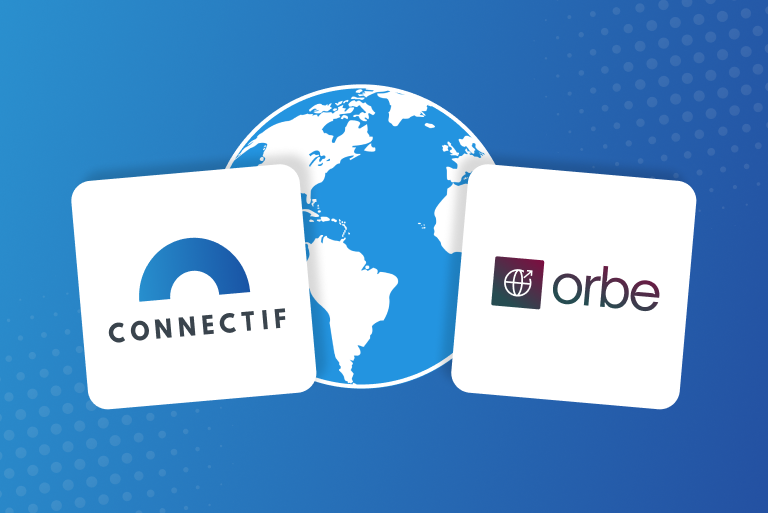Is your eCommerce already using automation? Good. Are you doing it with your own strategy and data? Therein lies the difference.
Our essential report for anyone who lives and breathes eCommerce, like us, is back. For the second time, Connectif has joined Ágora Digital, Product Hackers, Qapla’ and Apisearch to study the state of marketing automation in Spain and Latin America. This new study reveals an uncomfortable truth: many brands are automating but few do it intelligently.
If the first study gave us the signs, this one confirms them: marketing automation is no longer a “nice to have” for online stores. It’s a must-have. A foundation on which to scale operations, transform the customer experience and drive valuable insights in real time. Without automation, an eCommerce has no sense of direction in which to grow.
While the use of marketing automation is increasing, from 62% in 2024 to 70.9% this year, most businesses are still stuck on the surface level. Anonymous traffic is not tracked, personalization is not yet contextual and AI falls short.
So, let’s get to the data. And, above all, what it means to you and the opportunities that you can use as a marketer.
Who took part in the study?
234 companies took part in this second edition, 87% more than in 2024. The majority are from Spain (84.9%), but Latin American voices are growing, especially from Argentina, Chile and Colombia.
In terms of business models, B2C maintains its leadership in digital maturity, but watch out for B2B, whose representation has grown significantly. Automations applied to lead nurturing, lead scoring or segmentation processes are beginning to make inroads in sectors traditionally slower to adopt this technology.
And if we talk about context, there are two key factors:
● The majority of companies are digital SMEs: only 7.3% have a turnover of more than 50 million.
● In terms of CMS, PrestaShop still reigns supreme (40.5%), but WooCommerce and Shopify tie with 13.8%, reflecting an increasingly hybrid ecosystem.
In short: eCommerce is in full transition. It’s becoming more professional, but there is still a long way to go. And this is precisely where the real protagonist of this study comes into play: marketing automation as a digital growth accelerator.
Automation drives digital growth
Automation is not just a competitive advantage, it’s a condition for bigger revenues. No question.
The data says it all: 85.2% of companies with a turnover between 10 and 50 million already use marketing automation. And among those exceeding 50 million, 70.6% also have integrated automations.
At the other extreme, however, among companies with revenues of less than €100,000, more than 60% still don’t use marketing automations. And of course, that’s where growth stagnates. Because if an eCommerce business wants to sell more, it needs to automate more. It’s as simple as that.
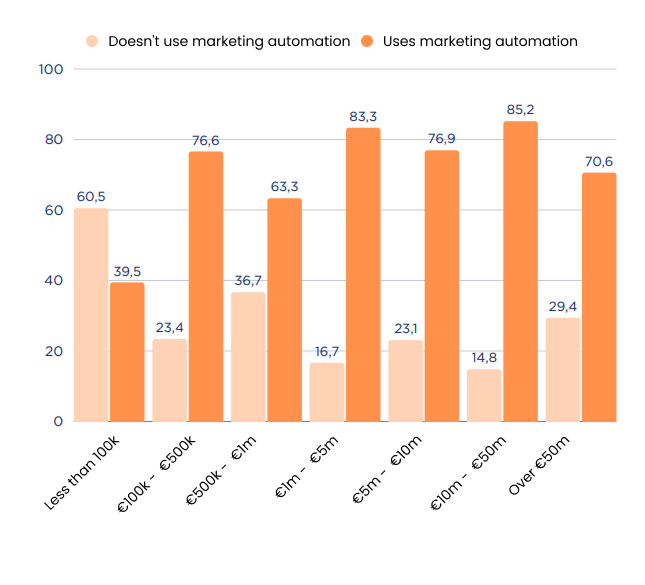
Source: Ágora Digital
If we’re talking about growth, it’s the same story: 85.7% of companies that grew between 30% and 50% use marketing automation. In the 20%-30% range, 82.5%. Even at low growth rates, most automate.
And those who did not grow at all? 59.5% do not automate. It couldn’t be clearer.
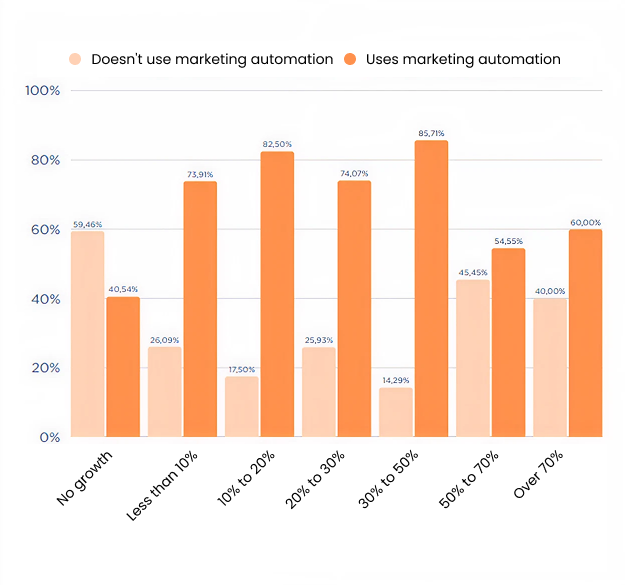
Source: Ágora Digital
The conclusion? Automating is closely linked to scaling online sales. It’s not magic: it’s method, data and continuous execution without relying on manual resources. Automation systematizes intent. And that, in eCommerce, is the smart way to grow.
Investment is growing, but still doesn’t reflect real value
This year, only 30.9% of companies will spend more than 10% of their digital budget on automation. But here’s the interesting twist: many of those with lower investments in automation are already generating more than 10% of their sales as a result of it.

Source: Ágora Digital
What does it mean? That the ROI is there, even for small budgets.
The problem isn’t money. The problem is that many brands don’t know where to start, what to automate first, or how to sustainably scale their online stores.
And this is where opportunities are lost.
Many eCommerce businesses still don’t understand the real value of data, of working with advanced metrics such as CLV, RFM, P-Alive or Churn, or having access to real-time reports that allow you to adjust campaigns while they’re live, not weeks later.
And many people still don’t know how to turn data into decisions and decisions into results. But when they do, they discover that automating isn’t just about operational efficiency, it’s about building truly personalized shopping experiences – based on user behavior, with context and relevance. That’s what turns automation into a real competitive advantage and a steady source of revenue.
Companies that are underinvesting run the risk of continuing to spend on manual campaigns that don’t scale, while others build systems that work on their own.
The barrier isn’t technical. It’s a mental one, and the first to get past it will run faster than the rest.
Active workflows: the great performance indicator
The number of active workflows remains a foolproof barometer. Using marketing automation is not the same as using it well. And the numbers make it clear: more than half of eCommerce businesses still work with fewer than 10 active flows, and only 6.7% have passed the 30 mark.
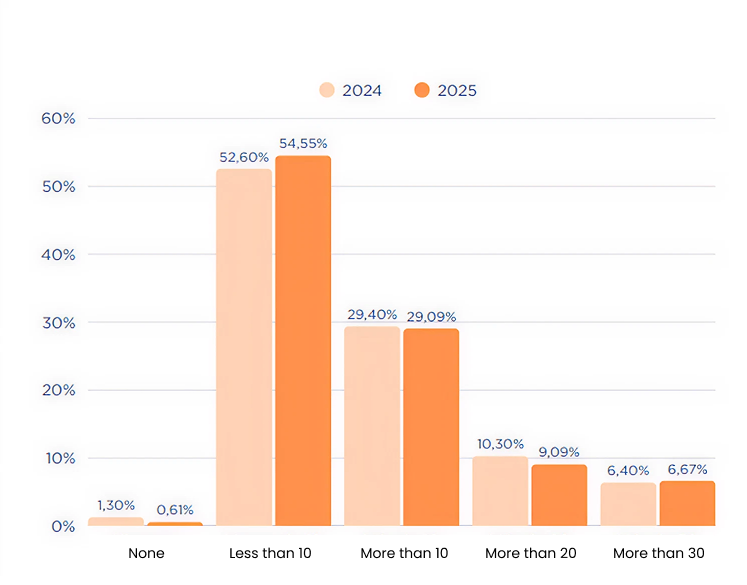
Source: Ágora Digital
What does it mean? That most are still in basic mode. A couple of newsletters, an abandoned cart reminder and little else. But that’s not a strategy. That’s the bare minimum.
Now look at the other extreme: companies with more than 30 active workflows attribute more than 80% of their sales to automation. This is no coincidence. These companies aren’t running lots of one-off campaigns. Instead, they’re using solid strategies: acquisition workflows, retention, reactivation, up-selling… all connected and designed to adapt to each stage of the customer journey.
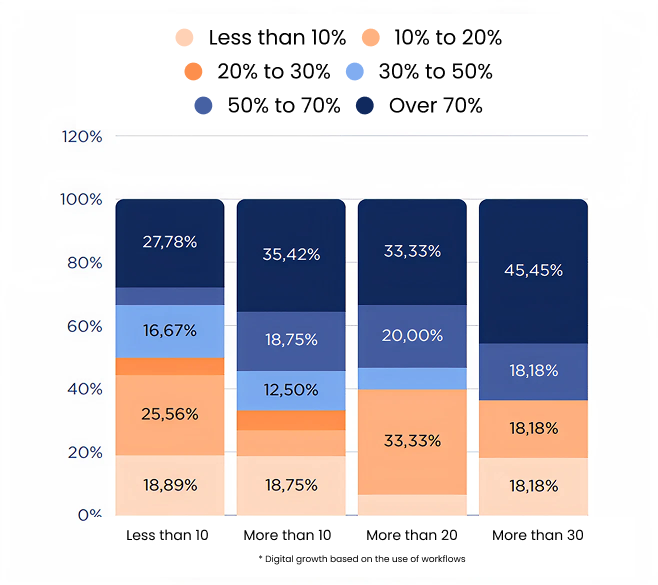
Source: Ágora Digital
And the reality is that you no longer need a technical team to get there. Today you can go live in minutes with preconfigured templates, adapt flows with drag & drop, and launch campaigns without writing a single line of code. There’s a ready-to-use workflow to meet your online store’s every need, literally.
Want to hear an interesting fact? Within Connectif, the average number of active workflows used by the most profitable eCommerce companies is 20. This is the tipping point where automation begins to return its full potential.
Because the eCommerce business that scales doesn’t launch one-off campaigns, it designs systems that work on their own. And it shows in every result.
Segmenting for scale: from emailing to behavioral
75% of eCommerce businesses still mainly use marketing automation to send newsletters. Nothing new there. But what is changing, and fast, is that they are increasingly using it for better targeting (45%) and to optimize conversions (54%).

Source: Ágora Digital
That’s the sign that something is evolving: automation is no longer a dispatch tool but a decision engine.
And the change is not only technical – it is strategic. Segmentation no longer revolves around demographics or static lists. Now the focus is on actual user behavior: how they shop, how much they spend, how often or when they’re about to leave.
Segmentations such as RFM – although down slightly from the previous year – are still the most widely used, because they show you at a glance which customers are most likely to repeat a purchase, who is losing value or who might spend more if given the right incentive.
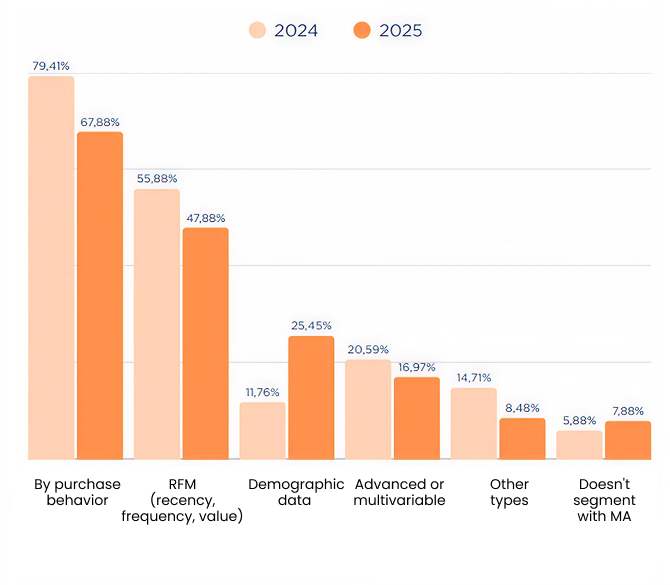
Source: Ágora Digital
The opportunity lies in going beyond the classic “you might also like”. It’s about designing strategies that fit the exact moment for the user: one campaign to reactivate high-value dormant customers, another to reward the most loyal, another to push the first purchase with relevant content based on the user’s behavior.
When the data tells you who to talk to, the important thing is to have a clear strategy for what to say. This is where marketing automation ceases to be generic and becomes an important growth lever.
Channels: from mass mailing to strategic orchestration
Email leads the way, as usual (96.9%). But WhatsApp is soaring (66%) and other channels such as social networks, forms, phone, pop-up and push notifications continue to occupy the top positions.
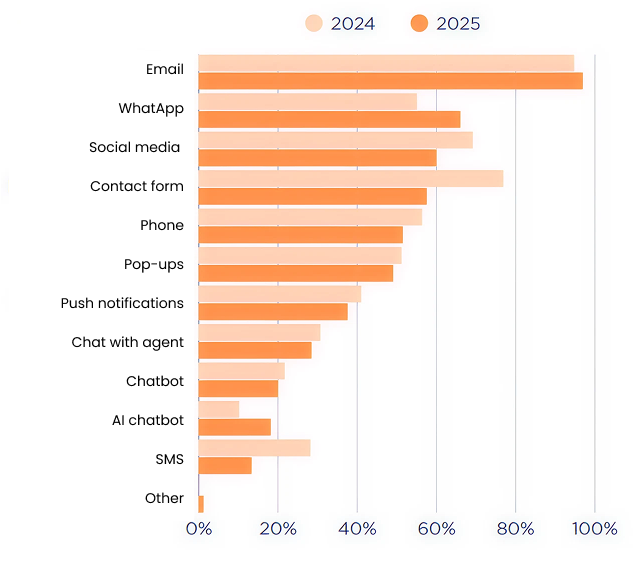
Source: Ágora Digital
The key is not in using lots of channels, however. It’s in connecting them together, in delivering a consistent, omnichannel experience that moves with the user. A push notification reminder if they didn’t open the email. A home page banner tailored to what they searched for a few days ago. A product suggestion by email based on what they saw on social media. A loyalty card to earn points both online and in the physical store.
That’s real omnichannel: consistency between content, channel and timing.
How to use marketing automation?
All the signs so far are pointing in one direction: automation is moving away from being a mere output channel and becoming a strategic driver.
However, there are three key areas with immense room for improvement – and where the results, when done well, are spectacular: anonymous user tracking, the use of artificial intelligence, and personalized recommendations.

Source: Ágora Digital
The big blind spot: anonymous traffic
Here’s a fact that shouldn’t be overlooked: only 37.6% of eCommerce businesses track anonymous traffic. And in an environment where 80% of visitors are unidentified, this is a serious problem.
Because yes, capturing traffic is good. But if you don’t know what that 80% is doing on your website from the first second, it’s like having a store full of people and not knowing why they are there.
Are they interested? Are they ready to purchase? Are they lost? What product are they looking for?
The key is to track their digital footprint from the first second, without waiting for them to register or come back. Because you can. And it changes everything.
From that first session, you can detect if they enter a specific category, look at several products without adding them to the cart or if they visit a landing page more than once. From there, you can activate pop-ups with subscription incentives, show personalized recommendations according to the products they have visited, or launch any kind of workflow to capture them.
Every visit is an opportunity. And if it’s not captured in time, it’ll disappear.
Remember: anonymous traffic is not invisible. You just need tools that know how to look at it from the first moment. And at Connectif, we know what we’re talking about.
Smart recommendations that sell more
61% of eCommerce businesses already have product recommendations activated. But most are still using the basics: “best sellers”, “most viewed”, “favorites of the month”. Useful, yes. But far from what a well-developed recommendation can do.
The real difference is in how the data is used. And that’s where true personalization comes in: making recommendations based on actual user behavior, not on what works for everyone. That means working with first-party data: what the user has seen, how long they have spent on a page, which categories they prefer, which channel they came from or how often they return.
Many brands working with Connectif are already applying it with real results. Fashion brands send post-purchase emails with ideas to complete the look while tech brands launch automated cross-selling strategies with accessories that are compatible with the item in the cart. And there are cosmetics stores that show pop-ups with personalized beauty routines according to favorite products, or decor sites that personalize the home page depending on the last categories visited by the user.
All of this happens without manual intervention. Just connected data, a well-defined logic and an automation that responds to the user in real time.
Recommending is not showing. It’s getting it right. And when you do it with what you already know about your customers, each impression becomes more useful, more relevant… and more profitable.
AI: from promise to real leverage
Let’s talk about artificial intelligence – a subject that’s probably already on your radar, and rightly so. What was once a buzzword has become a real and practical tool that’s transforming the way marketers plan, execute and scale their strategies.
Over the last year, the use of AI in eCommerce has gone far beyond simple content generation. In fact, according to the report, 48% of brands are already using AI for product recommendations and 31% are applying it in advanced audience segmentation. We’ve moved beyond one-off tests: these applications are becoming part of the core of many marketing strategies.
And the benefits are obvious: AI allows you to save time on manual and repetitive tasks so you can focus on what really delivers value – like designing creative campaigns, fine-tuning your strategy and strengthening your customer relationships.
However, while today’s automation tools can help you work faster, they still often work with pre-defined processes. You need to establish every condition, every rule and every action in advance. And that can be limiting, especially when customer behavior changes rapidly or when you need to scale personalization across multiple channels.
This is where agentic AI comes into play. Agentic AI is a paradigm shift from task-based automation to goal-focused collaboration. Instead of setting up complex step-by-step flows, you’ll soon be able to simply describe what you want to achieve and intelligent agents will define the best way to achieve it. These agents will be able to orchestrate campaigns, update customer segments, personalize content and optimize results in real time.
The real challenge now is to integrate AI naturally into your day-to-day life as a marketer, always connected to your customers’ behavior and focused on generating tangible results. Because by adopting these tools, you are not only incorporating technology: you are redefining the way you work, think and create.
At Connectif, we believe this is the future of marketing automation. We’ve already taken the first step with Copilot, our AI-powered assistant that helps you create content, and we’re working to expand these capabilities and enable you to do much more, with less effort and greater agility. Or, to put it another way: this is where you can really make a difference.
Final reflections on the study
If you’ve made it this far, it’s clear: marketing automation is already in place, but many marketers are not taking advantage of its full potential.
And if you’re wondering “So what do I do to make a difference?”, here are some practical tips:
- Track anonymous traffic from the first visit: don’t wait for users to register before you start interacting with them.
- Use first-party data, it’s a gold mine: your users’ behavior always gives you clues about what they need.
- Go beyond email: connect channels and create consistent experiences between email, web, WhatsApp, push, online and offline.
- Segment logically: use advanced metrics to better target your campaigns and be more relevant.
- Personalize your recommendations: don’t show “best sellers”, show what makes sense for each user.
- Use AI with purpose: not just to generate copy, but to save time, make better and faster decisions and launch strategies in a matter of seconds.
And if all of this sounds difficult and complicated or you don’t know where to start, remember that Connectif can help you with everything.



